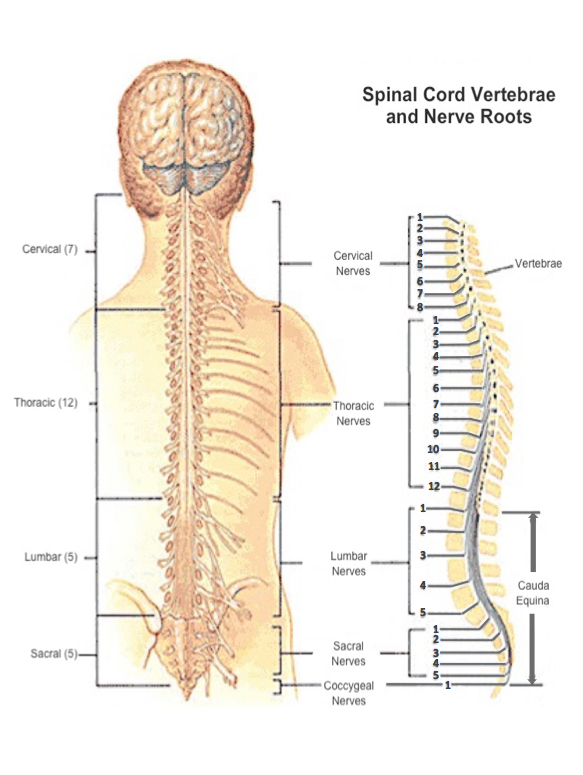
*Music boosts your IQ and EQ. Try my favorite music while reading the article.
*Overall information:
-Spinal cord and brain are part of the central nervous system. Brain sends down impulses to the spinal cord and this structure will act like a pathway for messages to be sent to the body or from the body back to the brain. Spinal nerves receive information from the spinal cord and stimulate other body organs as well as receive sensory messages from our body’s organs and send them back to the brain.
*Spinal cord:

-The spinal cord is about 40 to 50 cm long and 1 to 1.5 cm in diameter. It is a cylindrical structure of nervous tissue composed of white and grey matters.
-The spinal cord exits out of the skull via the foramen magnum and ends at the sacrum.
-The spinal cord is divided into five segments:
+Cervical, thoracic, lumbar, sacral, coccygeal segments.
-Each segment contains:
+Different amounts of vertebrae which have a function of protecting the spinal cord and nerve roots. They also provide structural support and maintain our posture. It also enables flexible motion.
+The nerves that come out of the cord are called spinal nerves.
-There are a total of 31 pairs of spinal nerves.
+Cervical segments have 8 pairs of spinal nerves. All of them exit above their respective vertebrates, except the last cervical spinal nerve which exists above the T1 vertebrae. They supply skeletal muscles of the upper limb.
+Lumbar segments have 12 pairs of spinal nerves and all of them exit below their corresponding vertebrates. Additionally, there is a bulbous region called lumbar enlargement in the lumbar segment from L2 to S3 because of the additional amount of gray matters. This bulbous region gives nerves that supply the lower limbs. From L2 tp coccygea 1, there is a bundle of spinal nerves which is called canada equina. These nerves provide the ability to move and feel sensation in the leg and bladder.
+Sacral segments consist of five pairs of spinal nerves. They control the function of pelvic organs and sex organs.
+Coccygeal segment contains 3 to 5 fused spinal nerves that supply several muscles, ligaments, tendons.
-Cross section:

+The spinal cord is made up of gray and white matter. There are 4 surfaces: anterior, posterior, and 2 lateral sides.
+The gray matter is a butterfly-shaped structure at the center of the spinal cord. It consists of neuron cell bodies with dendrites coming off from them.
+The white matter surrounds the gray matter and contains axons with myelin sheets that allow the conduction of action potential. Many pathways (ascending and descending pathways) cross the white matter to connect the brain with the rest of our body.
+As we go up from the coccygeal to cervical segments, white matter will increase but the amount of gray matter decreases. Cervical, thoracic, lumbar, sacral, occygral segments take sensory information and send it to the cortex. Thus, as you go upward, the amount of sensory information being carried will increase and the amount of gray matter will drop. The same concept applies to descending tracts where white matter will decrease and gray matter will increase.
*Spinal nerve
-Anterior and posterior root: attack spinal nerve to the cord. These roots will then come together and fuse to form the spinal nerve before splitting up and going to the back of our body (dorsal rami) and to the front (ventral rami).
-Spinal nerve contains both mixed motor and sensory fibers.
-Spinal nerves are grouped as cervical (C1-C8), thoracic (T1-T12), lumbar (L1-L5), sacral (S1-S5), and coccygeal (Co1), depending from which segment of the spinal cord they extend.
